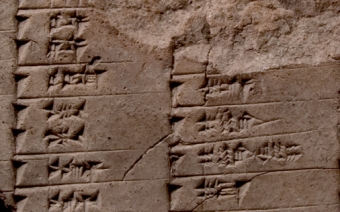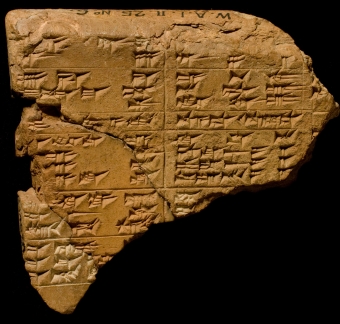Royal Lexicography: Introduction

K 135. Example of a sign list from the Nineveh collection: Paleographic Syllabary B (with archaizing sign forms). Photograph © British Museum, London.
The royal Library of Assurbanipal (668- ca 630 BCE) at Nineveh (modern Mosul) is the earliest systematic collection of the entire extent of scholarship of the time, and merits comparison with the library of Alexandria several centuries later, or our own Library of Congress. The library was abandoned when Nineveh was sacked in 612 BCE, to be discovered more or less intact by early excavators who explored the area in the mid-nineteenth century. The number of tablets is currently estimated between 25,000 and 30,000 texts and fragments. The excavated palaces not only yielded a comprehensive collection of traditional Mesopotamian knowledge, such as divination compendia, prayers, narratives, rituals, and lexical texts, but also royal correspondence and other archival material. The archival texts throw light on the workings of this empire and on the actual use and function of ancient knowledge in decision-making at the Assyrian court. Assurbanipal's library, therefore, is not only the earliest comprehensive scholarly library in known history, it is also the only one from the ancient world that allows insight into the way scholarship was used for royal legitimation and policy making.

K 2060. Example of a word list from Nineveh: Antagal. Sumerian entries (in the left column) are translated in Akkadian in the right column. Antagal is almost exclusively found at Nineveh and is divided into brief thematic sections by horizontal rulings. Photograph © British Museum, London.
The present site aims at publishing and understanding one sub-set of this immense collection: the approximately 1,000 lexical tablets. Lexical texts, word lists and sign lists, had existed since the very beginning of cuneiform writing in the late-Uruk period, some 2,500 years before the times of Assurbanipal. In the Neo Assyrian period lexical texts were used in three different ways: for scribal education, as objects of collecting, and for interpreting the received tradition.
The library of Assurbanipal is an expression of the power and wealth of the Neo Assyrian kings, and of the important place of scholars and scholarship in the protection of the king at the Neo Assyrian royal court. An excellent introduction to the society and politics of the time may be found in the pages of Knowledge and Power in the Neo-Assyrian Empire.
The Ashurbanipal Library project at the British Museum, London, where all the cuneiform tablets from Nineveh are housed, aims at providing a full digital inventory of the entire collection in cooperation with the University of Mosul, Iraq.
27 Dec 2019Further reading
- Frame, Grant, and Andrew R. George 2005 The Royal Libraries of Nineveh: New Evidence for King Ashurbanipal's Tablet Collecting. Iraq 67: 265-84.
- Goldstein, Ronnie 2010 Late Babylonian Letters on Collecting Tablets and Their Hellenistic Background - a Suggestion. Journal of Near Eastern Studies 69: 199-207.
- Parpola, Simo 1983 Assyrian Library Records. Journal of Near Eastern Studies 42: 1-30.
Niek Veldhuis
Niek Veldhuis, 'Royal Lexicography: Introduction', Royal Lexicography: Cuneiform Lexical Texts from Nineveh, The DCCLT Project, 2019 [http://oracc.museum.upenn.edu/dcclt/nineveh/introduction/]